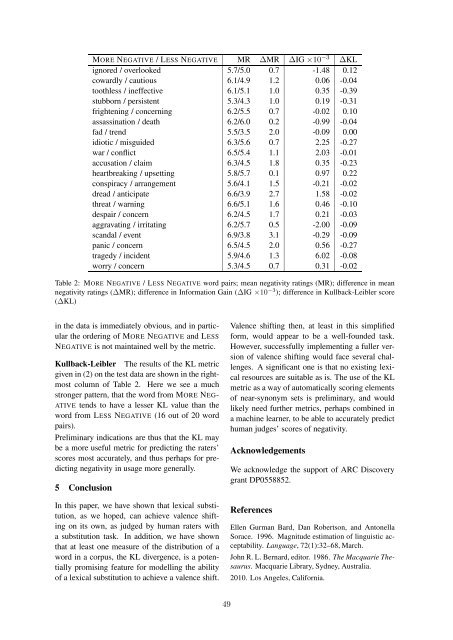Full proceedings volume - Australasian Language Technology ...
Full proceedings volume - Australasian Language Technology ...
Full proceedings volume - Australasian Language Technology ...
Create successful ePaper yourself
Turn your PDF publications into a flip-book with our unique Google optimized e-Paper software.
MORE NEGATIVE / LESS NEGATIVE MR ΔMR ΔIG ×10 −3 ΔKL<br />
ignored / overlooked 5.7/5.0 0.7 -1.48 0.12<br />
cowardly / cautious 6.1/4.9 1.2 0.06 -0.04<br />
toothless / ineffective 6.1/5.1 1.0 0.35 -0.39<br />
stubborn / persistent 5.3/4.3 1.0 0.19 -0.31<br />
frightening / concerning 6.2/5.5 0.7 -0.02 0.10<br />
assassination / death 6.2/6.0 0.2 -0.99 -0.04<br />
fad / trend 5.5/3.5 2.0 -0.09 0.00<br />
idiotic / misguided 6.3/5.6 0.7 2.25 -0.27<br />
war / conflict 6.5/5.4 1.1 2.03 -0.01<br />
accusation / claim 6.3/4.5 1.8 0.35 -0.23<br />
heartbreaking / upsetting 5.8/5.7 0.1 0.97 0.22<br />
conspiracy / arrangement 5.6/4.1 1.5 -0.21 -0.02<br />
dread / anticipate 6.6/3.9 2.7 1.58 -0.02<br />
threat / warning 6.6/5.1 1.6 0.46 -0.10<br />
despair / concern 6.2/4.5 1.7 0.21 -0.03<br />
aggravating / irritating 6.2/5.7 0.5 -2.00 -0.09<br />
scandal / event 6.9/3.8 3.1 -0.29 -0.09<br />
panic / concern 6.5/4.5 2.0 0.56 -0.27<br />
tragedy / incident 5.9/4.6 1.3 6.02 -0.08<br />
worry / concern 5.3/4.5 0.7 0.31 -0.02<br />
Table 2: MORE NEGATIVE / LESS NEGATIVE word pairs; mean negativity ratings (MR); difference in mean<br />
negativity ratings (ΔMR); difference in Information Gain (ΔIG ×10 −3 ); difference in Kullback-Leibler score<br />
(ΔKL)<br />
in the data is immediately obvious, and in particular<br />
the ordering of MORE NEGATIVE and LESS<br />
NEGATIVE is not maintained well by the metric.<br />
Kullback-Leibler The results of the KL metric<br />
given in (2) on the test data are shown in the rightmost<br />
column of Table 2. Here we see a much<br />
stronger pattern, that the word from MORE NEG-<br />
ATIVE tends to have a lesser KL value than the<br />
word from LESS NEGATIVE (16 out of 20 word<br />
pairs).<br />
Preliminary indications are thus that the KL may<br />
be a more useful metric for predicting the raters’<br />
scores most accurately, and thus perhaps for predicting<br />
negativity in usage more generally.<br />
5 Conclusion<br />
In this paper, we have shown that lexical substitution,<br />
as we hoped, can achieve valence shifting<br />
on its own, as judged by human raters with<br />
a substitution task. In addition, we have shown<br />
that at least one measure of the distribution of a<br />
word in a corpus, the KL divergence, is a potentially<br />
promising feature for modelling the ability<br />
of a lexical substitution to achieve a valence shift.<br />
Valence shifting then, at least in this simplified<br />
form, would appear to be a well-founded task.<br />
However, successfully implementing a fuller version<br />
of valence shifting would face several challenges.<br />
A significant one is that no existing lexical<br />
resources are suitable as is. The use of the KL<br />
metric as a way of automatically scoring elements<br />
of near-synonym sets is preliminary, and would<br />
likely need further metrics, perhaps combined in<br />
a machine learner, to be able to accurately predict<br />
human judges’ scores of negativity.<br />
Acknowledgements<br />
We acknowledge the support of ARC Discovery<br />
grant DP0558852.<br />
References<br />
Ellen Gurman Bard, Dan Robertson, and Antonella<br />
Sorace. 1996. Magnitude estimation of linguistic acceptability.<br />
<strong>Language</strong>, 72(1):32–68, March.<br />
John R. L. Bernard, editor. 1986. The Macquarie Thesaurus.<br />
Macquarie Library, Sydney, Australia.<br />
2010. Los Angeles, California.<br />
49














